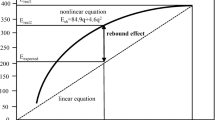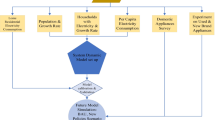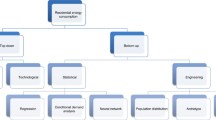Abstract
Between 1995 and 2008, Thailand’s energy efficiency programs produced an estimated total of 8,369 GWh/year energy savings and 1,471 MW avoided peak power. Despite these impressive saving figures, relatively little future scenario analysis is available to policy makers. Before the 2008 global financial crisis, electricity planners forecasted 5–6% long-term increases in demand. We explored options for efficiency improvements in Thailand’s residential sector, which consumes more than 20% of Thailand’s total electricity consumption of 150 TWh/year. We constructed baseline and efficient scenarios for the period 2006–2026, for air conditioners, refrigerators, fans, rice cookers, and compact fluorescent light bulbs. We drew on an appliance database maintained by Electricity Generating Authority of Thailand’s voluntary labeling program. For the five appliances modeled, the efficiency scenario results in total savings of 12% of baseline consumption after 10 years and 29% of baseline after 20 years. Approximately 80% of savings come from more stringent standards for air conditioners, including phasing out unregulated air conditioner sales within 6 years. Shifting appliance efficiency standards to current best-in-market levels within 6 years produces additional savings. We discuss institutional aspects of energy planning in Thailand that thus far have limited the consideration of energy efficiency as a high-priority resource.









Similar content being viewed by others
Notes
One exception is a zero-interest loan program for air conditioners, which attracted little consumer interest, largely due to excessive paperwork requirements. Direct rebates (another option) face negative perceptions that they would unduly transfer wealth to more prosperous consumers.
As an alternative, McNeil et al. (2006) modeled refrigerator survivorship using a probability function normally distributed around a mean lifetime of 15 years.
References
Blumstein, C., Goldman, C., & Barbose, G. (2005). Who should administer energy-efficiency programs? Energy Policy, 33(8), 1053–1067.
Crossley, D., Maloney, M., & Watt, G. (2000). Demand-side management and energy efficiency in changing electricity businesses. Research Report No 3. Task VI of the International Energy Agency Demand-Side Management Programme. Final Version. Hornsby Heights. NSW, Australia: Energy Futures Australia Pty Ltd.
Department of Alternative Energy Development and Efficiency (DEDE) (n.d.). Rang matrathan phalitthaphan utsahakam chapo dan prasitthiphap phalang-ngan [Draft energy efficiency standards for eleven manufactured products]. http://ee.dede.go.th/labnetwork/th/news/detail.php?newsID=204&ModuleKey=allnews. Accessed 26 Nov 2009.
du Pont, P. (1998). Energy policy and consumer reality: The role of energy in the purchase of household appliances in the U.S. and Thailand. Dissertation, University of Delaware.
du Pont, P. (2005). Nam Theun 2 hydropower project (NT2). Impact of energy conservation, DSM, and renewable energy generation on EGAT’s power development plan. Bangkok: World Bank.
EGAT. (2006). Phaen kan chat kan dan kan chai fa pi 2549–2553 [Demand-Side Management Plan for Budget Years 2006–10]. Nonthaburi, Thailand: Electricity Generating Authority of Thailand, Demand Side Management and Planning Division.
Energy Star (n.d.). US energy star qualified refrigerators: Definitions for refrigerator and freezer product listing column headers. www.energystar.gov/index.cfm?fuseaction=refrig.display_products_excel. Accessed 3 Dec 2009.
Foran, T. (2006). Rivers of contention: Pak Mun Dam, electricity planning, and state–society relations in Thailand, 1932–2004. PhD Thesis, University of Sydney. http://hdl.handle.net/2123/1984. Accessed 8 Mar 2009.
Geller, H., Harrington, P., Rosenfeld, A. H., Tanishima, S., & Unander, F. (2006). Polices for increasing energy efficiency: Thirty years of experience in OECD countries. Energy Policy, 34, 556–573.
Ghanadan, R., & Koomey, J. G. (2005). Using energy scenarios to explore alternative energy pathways in California. Energy Policy, 33, 1117–1142.
Greacen, C. E., & Footner, J. (2006). Decentralizing Thai power: Towards a sustainable energy system. Bangkok: Greenpeace.
Greacen, C. E., & Palettu, A. (2007). Electricity sector planning and hydropower. In L. Lebel, J. Dore, R. Daniel, & Y. S. Koma (Eds.), Democratizing water governance (pp. 93–125). Chiang Mai: Mekong Press.
Kainou, K. (2006). Quantitative policy evaluation of the top runner method household appliance efficiency standards regulations in Japan by cost-benefit analysis. Research Institute of Economy, Trade & Industry. http://www.rieti.go.jp/en/publications/summary/06040001.html?styles. Accessed 21 Nov 2008.
Khummongkol, P. (2002). Energy consumption trend in residential sector. Report submitted to Department of Energy Development and Promotion. Bangkok: School of Energy and Materials. King Mongkut University of Technology Thonburi.
Kritiporn, P. (1999). Energy efficiency standards regime study. Prepared for National Energy Policy Office. Final report. Bangkok: ERM-Siam Co. Ltd.
Kushler, M., York, D., & Witte, P. (2006). Aligning utility interests with energy efficiency objectives: A review of recent efforts at decoupling and performance initiatives. Report U061. Washington, D.C: American Council for an Energy-Efficient Economy.
Limmeechokchai, B., & Chaosuangaroen, P. (2006a). Assessment of energy saving potential in the Thai residential sector: Long-range energy alternatives planning approach. (Paper presented at the 2nd Sustainable Energy and Environment Conference, Bangkok, Thailand).
Limmeechokchai, B., & Chaosuangaroen, P. (2006b). Energy saving potential in the Thai commercial and industrial sectors: Long-range energy alternatives planning in the small buildings and industries. (Paper presented at the 2nd Sustainable Energy and Environment Conference, Bangkok, Thailand).
Lu, S.-M., Huang, Y.-S., & Lu, J.-M. (2008). Planning an energy-conserving policy for Taiwan based on international examples of success. Energy Policy, 36, 2685–2693.
Mahlia, T. M. I., Masjuki, H. H., & Choudhury, I. A. (2002). Theory of energy efficiency standards and labels. Energy Conversion and Management, 43, 743–761.
McNeil, M., & Letschert, V. (2008). Future air conditioning energy consumption in developing countries and what can be done about it: The potential of efficiency in the residential sector. Paper LBNL 63203. Berkeley, CA: Lawrence Berkeley National Laboratory.
McNeil, M., Letschert, V., & Wiel, S. (2006). Reducing the price of development: The global potential of efficiency standards in the residential electricity sector. Berkeley, CA: Lawrence Berkeley National Laboratory.
National Statistics Office. (2004). Results of the whole kingdom statistical survey. Bangkok: National Statistics Office.
Phumaraphand, N. (2008). Energy efficiency. (Paper presented at the San sewana thang ok palang-ngan fai fah thai [Dialogue on Thai electric power solutions], Bangkok, National Economic and Social Advisory Council).
Santisirisomboon, J. (2001). Environmental emission abatement strategies in the energy sector: The integrated economic, environment and energy approach. PhD Thesis, Sirindhorn International Institute of Technology, Thammasat University.
Seehawong, R. (1998). Laksana kan chai palang-ngan nai ban yu asai [Electricity use in residential housing]. Master’s Thesis, King Mongkut University of Technology Thonburi.
Segal, M. D. (2004). Nam Theun 2 project economics interim summary report. Bangkok: World Bank.
Singh, J., & Mulholland, C. (2000). DSM in Thailand: A case study. Joint UNDP/World Bank Energy Sector Management Assistance Programme (ESMAP). Washington, D.C: World Bank.
Stockholm Environment Institute. (2006). Long-range energy alternatives planning system. Software version 26. Boston: Stockholm Environment Institute.
Swisher, J. N., Jannuzzi, G. D. M., & Redlinger, R. Y. (1997). Tools and methods for integrated resource planning. Riso, Denmark: United Nations Environment Program. Collaborating Centre on Energy and Environment. Riso National Laboratory.
Thailand Load Forecast Subcommittee. (1998). Rai ngan kan phayakorn khwam tong kan chai fai fah 2541 [1998 forecast of electricity demand]. Bangkok: National Energy Policy Office.
Thai Industrial Standards Institute (TISI) (2002). TIS 2134-2545. Thai industrial standard for air conditioners: Environment requirements; energy efficiency. http://www.tisi.go.th/standard/fulltext_e/tis2134_2545.pdf. Accessed 3 Dec 2009.
Thai Industrial Standards Institute (TISI) (2004). TIS 2186-2547. Thai industrial standard for household refrigerators: Environment requirements; energy efficiency. http://www.tisi.go.th/standard/fulltext_e/tis2186_2547.pdf. Accessed 3 Dec 2009.
United Nations Development Program (UNDP) (2006). Project executive summary: Barrier removal to the cost-effective development and implementation of energy efficiency standards and labeling project (BRESL). Proposal presented to the global environment facility. Global Environment Facility. http://www.gefweb.org/interior.aspx?id=17160. Accessed 21 Nov2007.
Vine, E., Hamrin, J., Eyre, N., Crossley, D., Maloney, M., & Watt, G. (2003). Public policy analysis of energy efficiency and load management in changing electricity businesses. Energy Policy, 31(5), 405–430.
Acknowledgments
The authors gratefully acknowledge contributions made by Charlie Heaps, Bundit Limeechokchai, staff in the Demand-Side Management Office, Electricity Generating Authority of Thailand, Louis Lebel, and two anonymous reviewers. Funding support came from IUCN—the World Conservation Union; the Mekong Program on Water, Environment and Resilience (funded by CGIAR Challenge Program on Water and Food); and from the Policy Research to Promote Development and Use of Renewable Energy and Energy Efficiency in Thailand project (funded by Thailand’s Energy Policy and Planning Office).
Author information
Authors and Affiliations
Corresponding author
Appendix
Appendix
Rights and permissions
About this article
Cite this article
Foran, T., du Pont, P.T., Parinya, P. et al. Securing energy efficiency as a high priority: scenarios for common appliance electricity consumption in Thailand. Energy Efficiency 3, 347–364 (2010). https://doi.org/10.1007/s12053-009-9073-7
Received:
Accepted:
Published:
Issue Date:
DOI: https://doi.org/10.1007/s12053-009-9073-7




